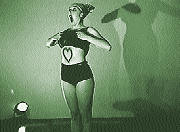 |
Lisa Ffrench, (H.T.D.A.P.H) How To Draw A Perfect Heart |
Part of the Festival of Contemporary Arts in Canberra, this collection titled To The Wall, was curated by choreographer Paige Gordon and her influence could certainly be seen in unifying elements across the programme; comedy, character-based drama and the use of song and dialogue. As she states in the program, her primary concern is “an interest in making dance accessible by making it entertaining”. While conforming to the aesthetic of the host company/choreographer raises obvious questions, it was actually great to see a dance collection that managed some kind of cohesion. The one factor that did divide the program—straight down the middle in fact—was the relative choreographic experience of Charlton, Ffrench and Berlyn, in comparison with McCarthy, Mullin and Rogis. Having said that, McCarthy’s piece Waiting showed promise in developing a single idea well.
Interestingly, the three more successful pieces shared a particular tendency within dance practice to choose between pure, choreographed movement sequences and a mixture of performance techniques including, but not privileging, movement. These choreographers chose the latter. The site specific Retail Therapy by Charlton is a case in point. In what amounted to an exercise in hyperbole, Ffrench, Berlyn, comedienne Darren Gisherman and Charlton herself began outside the window as drooling shoppers, drawn inside by an overwhelming, obsessive force and finally overcome in a frenzy of wanton consumerism that culminated in a song delivered cabaret style—“five dollars…only five dollars…”. Comedic skills are often demanded of dancers not up to the challenge, but in this case Charlton was lucky—or wise—in having genuinely funny people at her disposal.
In H.T.D.A.P.H. (How To Draw A Perfect Heart), Lisa Ffrench continued her often autobiographical project on obsessive human behaviour. Beginning with a Psycho-style shower scene, Ffrench confounds expectations when the bloody smears on the fake glass shower curtain take on the form of a heart. Emerging clad in a Glad-Wrap beehive and black slip, Ffrench’s monologue/dance develops around the image of the two-sided heart. The difficulty, when drawing hearts, to match the second half to the first becomes the obsession, the central idea which propagates to encompass many facets of love—disparity, co-dependence, two as one, obsession, repetition…this idea can go places not yet dreamt of by Ffrench which is proof of a good idea.
The final work for the evening was Berlyn’s Attraction Suite and sweet it was. Arrivals and departures, awkward casualness and polystyrene cups set up a party scene where a suite of couplings unfold. Fascination, excitement, boredom, duplicity…all the elements of attraction are depicted, with differing levels of comic sensibility from performers Charlton, McCarthy, Rogis and Simon Clarke. McCarthy’s performance as a panting, love sick party-goer, all trembling and swooning, was spot on. Berlyn’s own comic talent, given a regular airing by his alter-ego, the drag character Buffy, stood him in good stead.
Down a block, around the corner and up the hill a very different performance unfolded in a ‘proper’ theatre, also a part of the festival. What do Padma Menon, Diana Reyes, Nigel Kellaway and Gary Lester have in common? A production called Laya: Women Who Dare, presented by Padma Menon Dance Theatre. This is indeed a daring enterprise for Menon who lists herself as choreographer/artistic director, Reyes as flamenco tutor, Kellaway as dramaturgy assistant and Lester as contemporary tutor. (The dancers are credited as co-creators.) To have these four, individually distinctive, often formally unambiguous artists involved in the one project, suggests a significant central concept; one which could inspire, and furthermore, make imperative such collaborations. Cultural hybridisation is also implied in this list of contributing artists; a fusion of performance styles driven together by an artistic impulse clearly understood and committed to by all members involved. Needless to say, a lot to ask. Menon has aimed high in Laya… and by the end of the show, the perils of such an ambitious project are painfully evident. What is also clear is a recklessly daring spirit, a commendable choice of cast and an often sensitive treatment of a difficult theme.
Laya is about women—their sexuality, strength, victimisation and relationships with each other. Indian, Spanish and contemporary dance vocabularies are particularly rich for women, with female dancers being historically significant in terms of their creation and development. This goes some way towards explaining Menon’s choice of collaborators.
Diana Reyes’ virtuosic style of flamenco is exceptionally aggressive and strong, her compact figure demanding your attention and holding it. Indian dance can match Spanish in strength, and has a softer register that expresses a particularly feminine type of passion. Stylistically, both forms focus on the arms, hands, face and feet and in the first half these practical points of contact were worked through. The dancers, asked to be proficient in so many, incredibly complex forms, often appeared to be progressing step by step, the themes being left to some Kellawayesque illuminations, where screaming, retching and twitching said emphatically what the dance sequences alluded to. Somewhere amongst all this, contemporary dance served as a strange kind of link, filling in the gaps but never appearing point blank.
The second half was a completely different show; minimal, sensual and completely seductive. Bare backed, voluptuous women (Peta Bull and Jane McKernan were strongest in this half), caressed themselves and each other in simple movement sequences, alluding to auto-eroticism, lesbianism and the intimate, often silent communication between women. This idea developed alone could have said more than the formal crisis that the first half amounted to.
Laya, Padma Menon Dance Theatre; To The Wall, Paige Gordon and Performance Group, Festival of the Contemporary Arts, Canberra, October 18
RealTime issue #22 Dec-Jan 1997 pg. 34
© Erin Brannigan; for permission to reproduce apply to [email protected]








 back
back